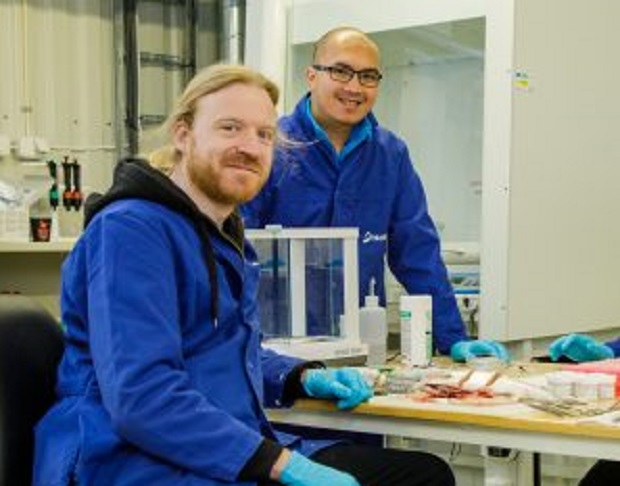
Industry update
News
Research
Searching for the optimal water velocity for fish growth
February 14, 2020 By Nestor Arellano
 Nofima’s Gerrit Timmerhaus and Carlo Lazado. (Photo: Terje Aamodt©Nofima)
Nofima’s Gerrit Timmerhaus and Carlo Lazado. (Photo: Terje Aamodt©Nofima) It is generally known that that smolt grow faster in recirculation systems when the water current is increased. Researchers for the Norwegian Institute of Food, Fisheries, and Aquaculture Research (also known as Nofima) have also found that swimming in strong currents help salmon grow bigger muscles.
Does this mean that operators of recirculating aquaculture system (RAS) facilities simply need to crank up water velocities in order to increase fish size? Not necessarily so, according to Gerrit Timmerhaus, a fish health researcher for Nofima.
Timmerhaus believes very high water velocities could be detrimental to fish health. It is not realistic to introduce water velocities that are much higher than the present-day standard in existing recirculation systems, according to the researcher.
That’s because this requires special equipment and powerful pumps suitable for achieving such high velocities. “He also doubts if it would pay off financially for very high settings, even if it did result in further increased growth,” a report from Nofima said.
The researchers divided post-smolt weighing 80g into groups that would swim for three months in water flowing at four different velocities. Post-smolt are salmon which just have passed through the smoltification stage and have become adapted to the sea.
The researchers wanted to test what happens to salmon physiology at different water velocities and whether or not there are any upper limits for beneficial effects. Water velocity is measured as body length per second.
The velocities that were tested were 0.5 body length/sec (low), 1 (medium), 1.8 (high) and 2.5 (very high). The researchers found that 2.5 body lengths per second is the highest velocity that has so far been tested on salmon smolt. In commercial recirculation systems, less than one body length per second is most common.
One of the findings in the trial was that weak currents resulted in a low condition factor – a long, narrow body shape. Strong currents resulted in relatively wider fish (a high condition factor) and increased growth rates due to muscle growth.
“Even though producers want a high percentage of muscle and rapid growth, the researchers do not know how this actual type of salmon would manage during the growth phase in the sea, and whether or not a low condition factor would be compensated for in the salmon by muscle growth at a later stage,” according to Nofima.
One finding in a previous trial conducted at Nofima showed that strong currents resulted in increased resistance to diseases.
Salmon swimming in strong currents swim in shoals and the researchers think that this is a sign that they are optimizing their use of energy. However, with increasing velocities, a higher proportion of skin damage was recorded, including scale loss and hemorrhagic patches.
Print this page